Green Level is an unincorporated community in southwestern Wake County, North Carolina, United States. It was founded c. 1800 and is one of the best preserved crossroads communities in the county. Although historically connected to the town of Apex, Green Level now lies within the municipal jurisdiction of the town of Cary.

Mount Auburn Historic District is located in the Mount Auburn neighborhood of Cincinnati, Ohio. It extends along both sides of Auburn Avenue roughly between Ringold Street and William H. Taft Road. The population of Mount Auburn was 5,094 at the 2020 census.

College Hill is a neighborhood in the west central section of the United States city of Greensboro, North Carolina. College Hill was Greensboro's first neighborhood.

The La Grange Historic District is a national historic district located in La Grange, North Carolina, United States. The district, originally encompassing 225 buildings and 1 structure, includes the historic commercial, residential, and industrial center of La Grange. The buildings include notable examples of Gothic Revival, Queen Anne and Bungalow/American Craftsman styles of architecture and date between the 1850s and the 1940s. Located in the district is the separately listed La Grange Presbyterian Church. Other notable buildings include the Sutton-Kinsey House, Walter Pace House, Sutton-Fields House, Colonel A. C. Davis House (1887), and the Rouse Banking Company Building (1908). The historic district was added to the National Register of Historic Places in May 2000.

Vernon Historic District is a national historic district located in Vernon and Vernon Township, Jennings County, Indiana. It encompasses 42 contributing buildings and 3 contributing sites in Vernon. The district largely developed between about 1830 and 1900, and includes notable examples of Italianate, Greek Revival, and Federal style architecture. Notable contributing resources include the Jennings County Courthouse (1859), American House tavern, "Rat Row" apartments, Jacob Clinton House (1834), nures drug store (1853),(odd fellows lodge)(1853),Judge Hickman New House (1832), John Bassnett House (1844), Gen. Robert S. Foster House (1840), Methodist Church (1817), Vernon Presbyterian Church (1832), Baptist Church (1871), a stone arch (1832), Tunnel Mill site, and Vinegar Mill site.
The Shepard Street–South Road Street Historic District is a national historic district located at Elizabeth City, Pasquotank County, North Carolina. The district encompasses 161 contributing buildings in a historically African-American section of Elizabeth City. The district developed from the mid-19th to mid-20th century, and includes representative examples of Greek Revival, Gothic Revival, Italianate, Queen Anne, Colonial Revival, Bungalow, and American Foursquare style architecture. Notable contributing buildings include the Sawyer–Pailin–Overman House, Antioch Presbyterian Church, (former) St. Catherine Catholic Church (1941), Olive Branch Missionary Baptist Church (1904), Corner Stone Missionary Baptist Church (1888), (former) St. Phillips Episcopal Church (1893), the Sundry Shop, Rex Cleaning Works (1932), Good Samaritan Hall (1896), and Republican Star Odd Fellows Hall.
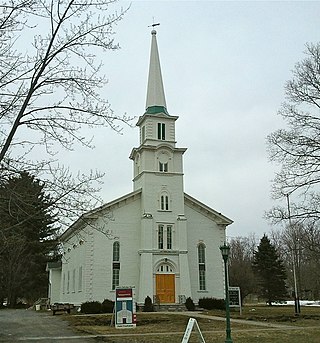
The Fabius Village Historic District in Fabius, New York is a 70-acre (280,000 m2) historic district that was listed on the National Register of Historic Places in 2000. It includes 57 contributing buildings, 2 contributing sites, 2 contributing structures, and 4 contributing objects.

Hedgesville Historic District is a national historic district located at Hedgesville, Berkeley County, West Virginia. It encompasses 55 contributing buildings and one contributing site, the Town Spring. Notable buildings include the Presbyterian Church and Manse, Ashton House, Robinson Log House, Hat Shop, Stuckey House, Westenhaver-McKee House, Mt. Zion Episcopal Church and Hedgesville Cemetery, Jacob Hull Mansion, and Bodine's Tavern. Included are notable examples of Queen Anne and Greek Revival-style architecture.
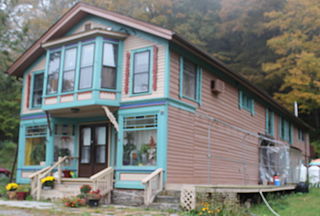
Damascus Historic District, is a national historic district located within Damascus Village in Damascus Township, Wayne County, Pennsylvania. The district includes 36 contributing buildings, 2 contributing sites, and 2 contributing structures in the community of Damascus. The buildings are in a variety of popular architectural styles including Greek Revival, Queen Anne, and Renaissance Revival. Notable buildings include the Baptist Church, Damascus Academy, Vail and Appley Store, Methodist Church (1857), Philip O'Reilly House, and Luther Appley House. The sites are the Hillside Cemetery and Overlook Cemetery.
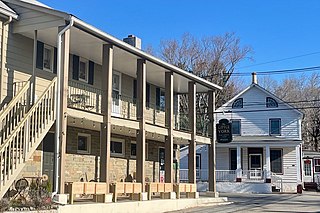
Little York is an unincorporated community located along the border of Alexandria and Holland townships in Hunterdon County, in the U.S. state of New Jersey. Little York is located on County Route 614 3.1 miles (5.0 km) north-northeast of Milford. Little York has a post office with ZIP Code 08834.

Waughtown–Belview Historic District is a national historic district located at Winston-Salem, Forsyth County, North Carolina. The district encompasses 1,137 contributing buildings, 1 contributing site, and 1 contributing object in a largely residential section of Winston-Salem. The buildings date from about 1834 to 1955, and include notable examples of Greek Revival, Colonial Revival, Queen Anne, and Bungalow / American Craftsman style architecture. Located in the district is the separately listed Shell Service Station. Other notable resources include the Clodfelter House, Fiddler House, Nissen Wagon Works smokestack, Triangle Body Works, Waughtown Baptist Church (1919), Waughtown Presbyterian Church (1914), Southside Christian Church, and Waughtown Cemetery.
Snow Hill Historic District is a national historic district located at Snow Hill, Greene County, North Carolina. The district encompasses 229 contributing buildings, a contributing site, two contributing structures, and a contributing object in the central business district and surrounding residential sections of Snow Hill. The buildings are in a variety of popular 19th and early-20th century architectural styles including Greek Revival, Gothic Revival, Colonial Revival, and, Bungalow / American Craftsman. Located in the district are the separately listed Greene County Courthouse and St. Barnabas Episcopal Church. Other notable buildings include J. Exum & Co. Grocery building, Harper Drugstore, Sugg-Harper House, Williams-Exum Housem, Murphrey-Morrill House (1885), Josiah Exum House (1887-1888), Alfred Warren House (1912-1915), Calvary Memorial Methodist Church (1928), Snow Hill Presbyterian Church (1935), and former First Baptist Church.
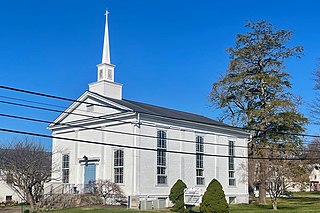
Mount Pleasant is an unincorporated community located along County Route 519 on the border of Alexandria Township and Holland Township, in Hunterdon County, New Jersey. The Mount Pleasant Historic District was listed on the National Register of Historic Places in 1987.

Reidsville Historic District is a national historic district located at Reidsville, Rockingham County, North Carolina. It encompasses 324 contributing buildings, 1 contributing site, 11 contributing structures, and 1 contributing object in the central business district and surrounding residential sections of Reidsville. It was developed between about 1865 and 1941, and includes notable examples of Italianate, Queen Anne, American Craftsman, and Classical Revival style architecture. Located in the district are the separately listed Penn House and Gov. David S. Reid House. Other notable buildings include the Oaks-Motley House, Colonel A. J. Boyd House (mid-1870s), Reid Block (1880s), Citizens' Bank Building, William Lindsey and company Tobacco Factory, First Baptist Church, Main Street Methodist Church, Melrose (1909) designed by architect Richard Gambier, R. L. Watt house designed by Willard C. Northup, First Presbyterian Church (1922), St. Thomas Episcopal Church, Grand Theatre, Belvedere Hotel, United States Post Office and Federal Building, and the Municipal Building (1926).

West Main Street Historic District is a national historic district located at Forest City, Rutherford County, North Carolina. It encompasses 27 contributing buildings, 1 contributing site, and 1 contributing object in a predominantly residential section of Forest City. The district developed after 1867, and includes notable examples of Colonial Revival and Bungalow / American Craftsman style architecture. Located in the district is the separately listed Cool Springs High School designed by Louis H. Asbury (1877-1975). Other notable contributing resources include the Cool Springs Cemetery, First Presbyterian Church (1940), the Cool Springs Gymnasium (1958), Lovelace-Ragin House (1928), Harrill-Wilkins House (1925), Frank B. and Mae Bridges Wilkins House, McDaniel House (1913), Biggerstaff-Griffin House (1925), and McMurry-Bodie House (1928).
Mount Olive Historic District is a national historic district located at Mount Olive, Wayne County, North Carolina. The district encompasses 465 contributing buildings, 2 contributing structures, and 1 contributing object in the central business district and surrounding residential sections of Mount Olive. It developed between about 1838 and 1949, and includes notable examples of Italianate and Queen Anne style architecture. Located in the district are the separately listed former United States Post Office, Mount Olive High School (Former), Southerland-Burnette House, and Perry-Cherry House. Other notable contributing buildings are the Elms, Mount Olive Presbyterian Church (1916), Carver High School (1941), Wooten & Brothers Building, DeBrutz English House, Center Theatre (1947), Mount Olive Manufacturing Company (1914), Farrior-Wooten House, Mount Olive First United Methodist Church (1911-1913), Mt. Olive Pickle Co. Office (1920), Mount Olive Passenger Depot, and Ebenezer Apostolic Holiness Church (1850).

Welborn Historic District is a national historic district located at Mount Vernon, Posey County, Indiana. The district encompasses 154 contributing buildings and 5 contributing structures in a predominantly residential section of Mount Vernon laid out by Jesse Welborn between 1822 and 1826. It developed between about 1840 and 1942, and includes notable examples of Greek Revival, Gothic Revival, Italianate, Romanesque Revival, and Colonial Revival style architecture. Notable contributing buildings include the Gov. Alvin P. Hovey House, Edward Sullivan House (1860), C.P. Klein House Johnson-Rosenbaum House (1905), St. Matthew's Catholic Church (1880), First Presbyterian Church (1872), Trinity Evangelical Church (1883), St. John's Episcopal Church (1892), Mount Vernon Post Office (1931).
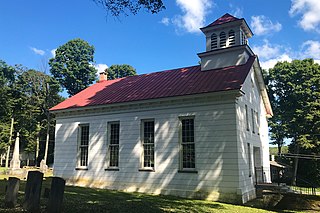
The Mount Olive Village Historic District is a 7-acre (2.8 ha) historic district located along Mount Olive Road and Flanders-Drakestown Road in the Mount Olive Village section of Mount Olive Township in Morris County, New Jersey, United States. The district was added to the National Register of Historic Places on August 3, 2015, for its significance in architecture and exploration/settlement. The district has two contributing buildings, the Mount Olive Baptist Church and the Mount Olive Academy, and three contributing sites.

















